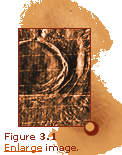|
|

Crater Morphology
Cratering was an important process shaping the Martian surface. Martian
crater morphology is extremely similar to that of the Moon and Mercury.
Small craters (< 10-15 km in diameter) show simple, bowl-shaped
depressions with raised rims as well as steep walls, and some may even
have small flat floors. Craters larger than these show more complexities,
such as central peaks and terraced walls. Craters larger than about 100
km in diameter show ring-peaks at the center and multi-ring structures.
 |
 |
Figure 3.1 is an example of a multi-ring crater on Mars. It is
about 100 km in diameter. Multi-ring craters on the Moon
and Mercury do not occur until they reach about 200 km across
or larger. This difference in size in the development of multi-ring
craters is probably due to the difference in gravity and/or the
difference in surface rock rheology because of the small amount
of water that might have existed on Mars.
|
Craters on Mars also appear to experience more erosion or other degradation
than those on the Moon and Mercury. This is believed to be the combined
result of a dynamic atmosphere (i.e., more intensive aeolian processes),
more active volcanism throughout the history of the planet, and more weathering
due to processes associated with the possible existence of water. 
1 2
3 next >
|



